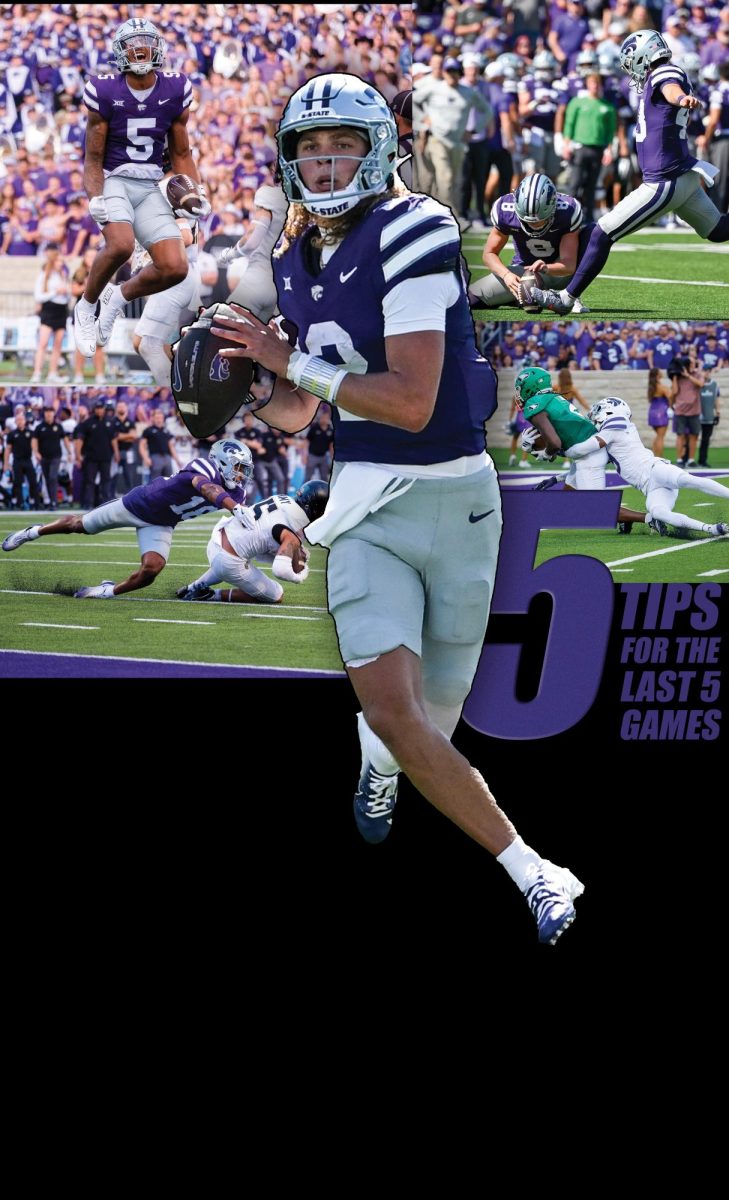
Photo illustration by Haley Smith
During pre-season rankings and predictions, the Kansas State Wildcats shone through at the top of many lists. Now with seven games under their belt and only five remaining, the playing style, camaraderie and talent of this team has set in. With fans closely examining the outcomes of previous games, curiosity and questioning are beginning to take root.
K-State has found itself at 3-4 overall and 2-2 in Big 12 play. This time last year, the Wildcats were 6-1 overall and 3-1 in conference play. While many K-State fans would say that the ‘Cats had a slow start to the season, the quality of football has improved since then. Despite having plenty of potential, this team has fallen short of the expectations placed on it.
Watching K-State football has not been anything less than a rollercoaster of emotions. One minute, feelings of anger and disappointment dwindle into cheering and excitement as the ‘Cats scored or made a key play in the overall game.
Even though the game of football can be surface-level, digging deep into player and team stats can help locate potential problems or places for improvement. Looking back at the last seven games, the Wildcats have shown the good, bad, ugly and talent of the purple and white lineup.
Tip No. 1
Offense needs to improve on 3rd and 4th down conversions. Watching the Wildcats’ games, this might have stood out, but looking directly at the stats, it’s an area of improvement. So far his season, K-State is 36-93 (38.710%) on 3rd down conversions, while opponents are close behind with 38-103 (36.893%). While the ‘Cats do have the advantage, there’s a small margin for errors, which head coach Chris Klieman and his team can’t afford.
It is difficult to regain the advantage when a team allows its opponent to control fourth-down conversions. While both K-State and its opponents are 9-18 on 4th down conversions, the competitor has the upper hand with a 57.143% effectiveness, while the Wildcats are at an even 50%.
To improve stats for both 3rd and 4th down conversions, the offensive line needs to diagnose the situation, communicate with their teammates and execute. Nevertheless, these steps sound easy on paper but become more difficult in the intense college football environment.
Tip No. 2
Eliminate turnovers. Over the years, K-State football has been quick with its possession time, resulting in fast drives along with a higher number of turnovers. Breaking down the seven games of the season thus far, there’s a trend in the making. When the ‘Cats are struggling to score, they force plays, leading to mistakes.
During the Arizona game, the Wildcats found themselves in a crunch situation where a stressful situation got the best of the ‘Cats. K-State started its drive with 4:24 left on the game clock, feeling pressure approximately two minutes after getting possession. With 2:31 left in the fourth quarter, Johnson locked eyes with Brown and threw a pass that deflected off of Brown’s hands, giving the ball back to Arizona. Attention to detail and discipline led to the ‘Cats first and only turnover of the game.
Another turnover at the end of the Army game was costly and didn’t help the Wildcats’ outcome. Just under the three-minute mark, the pattern of being in a win-or-lose situation developed once again. With 1:35 remaining in the game, a pass deflected off running back Joe Jackson and into the hands of Collin Matteson near midfield, allowing Johnson’s first pick of the season.
For the Wildcats to have a winning record, they must break the trend of simple errors occurring after the five-minute mark.
Tip No. 3
Defensively, the Wildcats are on the right track. Thus far, the ‘Cats are only allowing 27 points per game, ranking them 90th of 136 according to Sports Reference. While giving up 27 points is about average stat-wise, if K-State wants to go to the next level, then their defense needs to force stops and create turnovers more often.
While the defense may lack effort at times, it also depends on how long the defense is on the field. Looking back at the Knights, the defense was on the field for nearly an hour, so limiting opponents’ possession time and drives is key.
Tip No. 4
The Wildcats’ defense, giving up 5.42 yards per play, according to College Sports, could cause concern during higher competition. When opponents are getting more than six yards a play, K-State’s defense will struggle.
Giving up about 5.4 yards per play is tolerable in lesser or non-conference games since drives inevitably stop or the defense tightens up in the red zone. However, that increases rather than decreases when facing more competitive Big 12 opponents, who usually have more explosive athletes, superior quarterback play and higher offensive line production.
Tip No. 5
When the Wildcats struggle to score, they at least have the option to kick field goals. With kicker Luis Rodriguez, the 90.9% field goal attempt has helped keep K-State above water during stressful times. Rodriguez ranks 22nd nationally and fifth in the Big 12 with his high field goal percentage.
Rodriguez has made 10 of 11 field goals and all 24 extra-point attempts in his first seven games. At Baylor, he missed a 56-yard try as time ran out, which was his only miss this season.